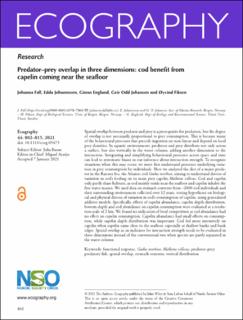| dc.description.abstract | Spatial overlap between predator and prey is a prerequisite for predation, but the degree of overlap is not necessarily proportional to prey consumption. This is because many of the behavioural processes that precede ingestion are non-linear and depend on local prey densities. In aquatic environments, predators and prey distribute not only across a surface, but also vertically in the water column, adding another dimension to the interaction. Integrating and simplifying behavioural processes across space and time can lead to systematic biases in our inference about interaction strength. To recognise situations when this may occur, we must first understand processes underlying variation in prey consumption by individuals. Here we analysed the diet of a major predator in the Barents Sea, the Atlantic cod Gadus morhua, aiming to understand drivers of variation in cod's feeding on its main prey capelin Mallotus villosus. Cod and capelin only partly share habitats, as cod mainly reside near the seafloor and capelin inhabit the free water masses. We used data on stomach contents from ~2000 cod individuals and their surrounding environment collected over 12 years, testing hypotheses on biological and physical drivers of variation in cod's consumption of capelin, using generalized additive models. Specifically, effects of capelin abundance, capelin depth distribution, bottom depth and cod abundance on capelin consumption were evaluated at a resolution scale of 2 km. We found no indication of food competition as cod abundance had no effect on capelin consumption. Capelin abundance had small effects on consumption, while capelin depth distribution was important. Cod fed more intensively on capelin when capelin came close to the seafloor, especially at shallow banks and bank edges. Spatial overlap as an indicator for interaction strength needs to be evaluated in three dimensions instead of the conventional two when species are partly separated in the water column. | en_US |
